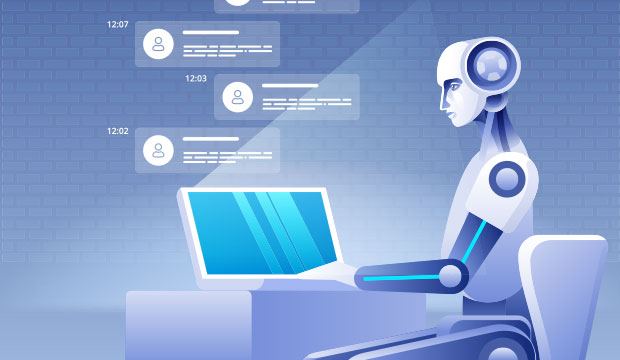Coronavirus has ushered upon us an era of isolation and curtailed face-to-face operations in favor of virtual interactions. The service of demand and delivery has shifted mainly to digital channels. While this trend was visible in the pre-COVID world, the global pandemic has accelerated digital-first engagement to something which has become known as the “new normal.”
However, as employees continue to work from home, businesses and their customer service/IT help desk teams are confronted with new challenges. They are witnessing an unprecedented level of demand, plus constant changes in support volume due to new platforms and remote working.
A recent Zendesk study found that there has been, on average, a 48 percent increase in the number of support tickets since last February witnessed on their platform. The study clearly shows that employees are heavily reliant on instant and quality technical support during this “remote everything” era.
The question now is: How can organizations transform their IT help desk operations amidst the ongoing COVID-19 crisis to ensure business continuity and high employee productivity without overburdening their IT help desk?
Round-the-clock self-service platforms, such as chatbots or virtual assistants, fueled by conversational AI and natural language processing (NLP), are helping organizations adapt and efficiently manage their employee and customer engagements during this challenging time.
How Chatbots and Virtual Agents Fit the Bill
Organizations are struggling to present employees working from home with efficient self-service options to ensure an uninterrupted flow of work and minimal business disruptions. An AI-powered chatbot that delivers a 24×7 self-service framework for employees is an ideal option. It can offer prompt support to basic employee issues and queries and quickly escalate complex interactions to human agents.
Chatbots or virtual agents can be deployed across multiple digital channels and devices — including webchat and SMS for text-based service delivery and phone calls and smart speakers for voice-based interactions.
Such conversational AI is scalable and can improve its performance with time as it leverages and learns from other data to optimize the quality of replies. Thus, it can be safely said that a chatbot gets smarter from experience, just like the best human agents.
Let’s take a deep dive into the benefits of chatbots and virtual agents, with six ways to improve employee productivity and streamline business operations in the new normal.
1. Provide Round-the-Clock and Instant Resolutions
In today’s remote working scenario, where employees have to manage kids, pets, and home responsibilities alongside their office duties, employees usually need to extend their working hours beyond the conventional 8 to 5 period. Therefore, organizations must have round-the-clock IT help desk support to provide instant resolutions to employee support requests.
Chatbots can tackle this aspect. Standard queries that would otherwise have to wait for at least a few hours can be resolved instantly by AI chatbots and without any human intervention. Industry studies suggest that modern-day chatbots can answer roughly 80 percent of standard questions.
2. Eliminate Time-Consuming Searches for Information
Chatbots can significantly improve the employee experience by transforming the way employees across an organization seek information. Take simple web searches as an example. Traditional online searches might deliver results that are completely irrelevant and thus useless for employees who then end up spending a lot of time making futile searches. Instead, specialized chatbots with a rich domain or technology-specific knowledgebase can provide the most relevant answers to employee searches instantly. The chatbot does the legwork for employees, which saves them time and helps them stay more productive.
3. Anchor Learning of New Technology Implementations
COVID-19 presents businesses with additional challenges every day. Organizations are implementing new cloud-based technologies to tackle such challenges. However, these new implementations can create roadblocks for employee productivity. Employees need the time and sufficient training to learn, adapt and utilize new technologies. Chatbots or virtual agents can address this problem by acting as a personal coach, mentor, and learning buddy that provides continuous and personalized support to fast-track the learning of a new system.
4. Automate Mundane Tasks and Liberate Talent
Much of the work within any organization is routine and repetitive. Chatbots help to liberate employees from monotonous tasks because they are designed to complete such tasks faster and more efficiently than humans.
Automating high demand, but low-level work, through a chatbot can free up essential time for employees who can instead spend this time taking up new initiatives that require human knowledge, intuition, and empathy.
Instead of being deluged by repetitive tasks, the chatbot allows your help desk agents to be more productive and solve only complex problems. Chatbots provide the agents time to research, learn and become more skilled at their jobs.
Automation can also help with the implementation of an organization-wide governance structure.
5. Extend Support in Native Language and Understand Context
Even if the majority of an organization’s employees are multilingual, they might be more at ease and productive when they interact in their native dialect. Language is often an important factor in the extent of training and assistance a business can deliver to its employees. Having an English-only support mechanism is not always ideal, especially if a company has employees and/or a presence in multiple nations.
Chatbots can offer multi-language support, which comes in handy when used in different regions marked by different languages. Thanks to built-in AI and NLP, the bots can understand the context of a conversation, quickly identify the purpose of employees’ queries, and provide the most appropriate responses.
6. Enable Efficient Access to Business Data
Chatbots are brilliant in the process of unifying data from each department, practice, and operation across the organization. They can be easily and quickly integrated with LOB applications (ticketing systems, Intranet, Microsoft Teams, etc.) and external sources. Once this is done, chatbots can act as concierges and fetch the data required from relevant data sources with just a ping. However, before enabling the information, bots do check for permission levels, identify the area of a query, check the access levels of the employee, and then respond accordingly.
Conclusion
COVID-19 has created a planet of minimal certainty. However, one thing we can surely anticipate is that chatbots will be a cornerstone of business continuity, employee productivity, and organizational growth during this digital-first new normal and beyond. In the months and years to follow, AI chatbots will be a leading force across industries and verticals.














































